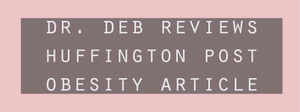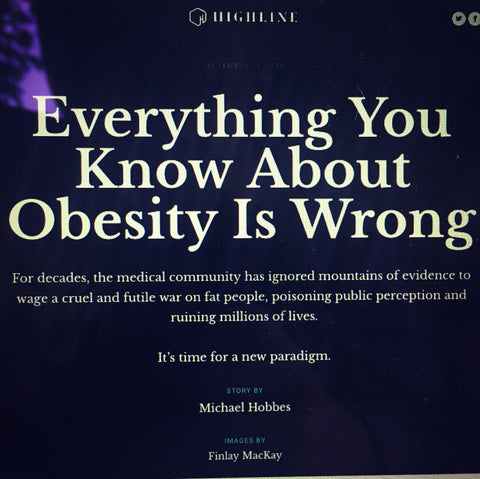Dr. Deb review and reflection on Huffington Post article, “Everything you know about obesity is wrong”, by Michael Hobbs
September 20, 2018

Dr. Deb review and reflection on Huffington Post article, “Everything you know about obesity is wrong”, by Michael Hobbs

This article brings attention to the true facts about obesity, and the dire lag in our medical system to catch up. I particularly appreciate the historical review of the countless times the medical profession has been wrong, very wrong, when it comes to “health”. I also appreciate the distinctions between weight and health. They are not synonymous with each other, yet our culture has viewed them to be directly related. I know, as I am sure you do too, many thin people who eat high calorie/low nutritious foods and many fat people who eat low calorie/ highly nutritious foods. Based on one factor, weight, these two people will have completely different experiences at the doctor.
I can relate to the journalist because, during the time that I conducted my interviews with “obese” fat women in 2012, I experienced the same thing. Nearly every women I interviewed cried. While my focus was on their experiences with clothing, the conversation touched on all parts of life, because, after all, clothing is what we live our lives in. (Links to my research and findings are below).
The medical measure of "health" has been weight which has translated into the fashion industry as clothing size. The smaller size you wear, the more status you have. The more respect you get when shopping and better options you have. Research shows that fat patients are treated poorer than thin patients and they are ascribed more ailments without any foundation. We see the same thing in fashion. Many designers create poor quality plus-size clothing because they assume that the plus-size consumer wants to loose weight, is actively trying to lose weight so the clothing they buy doesn't need to last long.
I am extremely grateful for a nationally recognized web newspaper, Huffington Post, to address weight bias and the severe damage inflicted upon fat people by the medical system. For me, it brings up all the other ways that our culture shames, belittles, and ridicules fat people. Unfortunately, it starts at such a young age, most of us don’t even know we do it. I’ve done several YouTube videos examining Fat Shaming and how it has permeated our lives. Honestly, most people can’t see they they despise fat and veil their hateful attitudes with “health”.
Here is a link to the Ask Dr. Deb Fat Shaming Series on YouTube. I define what it is, where we see it, what thin-privilege is and provide steps on how we can, as individuals, work to stop the horrific treatment of fat bodies.
I think the problem is that without education and awareness, most people DON’T SEE what is wrong. That is why, I have said over and over and over again, that we need to educate people on what weight bias looks like, and why it is harmful. No, it is not a fat person's fault for being fat.
This is also the main reason SO many fashion companies ‘get it wrong’ when it comes to serving their ‘plus-size’, fat and larger consumers. In their mostly thin opinion, they are doing something really great and helpful for fatties. When in fact, it is offensive and wrong. A passion of mine is to educate fashion companies on how they can identify their biases before launching a campaign or releasing a product. How many examples can we think of off the top of our heads?
We need a serious fashion revolution that does not judge or condemn people for their body size. And body size is just one part of an intersectional fashion ferris wheel where many marginalized groups are rejected from fashion expression. I'm working on finishing a book that is designed to help fashion companies, and the individuals that work there, recognize bias and make adjustments before the majority of the population is mistreated. If only there were more than 24 hours in a day!
In the mean time.... here is a list of publications, abstracts and articles about this topic.
Christel, Deborah. (2014). It’s your fault you’re fat: Judgements of responsibility and social conduct in the fashion industry. Clothing Cultures. 1. 10.1386/cc.1.3.303_1. [FREE DOWNLOAD]
Abstract: Examining the beliefs in the fashion industry surrounding the obese is critical to understanding discrimination issues and the resultant fit and sizing issues for plus-size consumers. The fashion industry offers certain styles in limited sizing, which in turn structures our society in such a way that only certain sizes can participate in choosing and wearing fashionable clothing. Therefore, the need to examine the people’s beliefs who will work in this industry is critical to restructuring the sizing, fit and discriminatory issues experienced by fat consumers. Understanding these beliefs among student designers, or the ‘gatekeepers’ of the fashion industry, may explain why plus-size women repeatedly report feeling discriminated against by the fashion industry and have difficulty finding clothing in styles, colours and fits they desire. The results of the study indicate that fashion design and merchandising students have strong negative beliefs about obese people. This article investigates the reasoning for such disdain towards obese bodies in the fashion industry and hopes to rectify the situation by offering suggestions
to normalize fat bodies and incorporate information about plus-size consumers into fashion design and apparel merchandising courses.
Christel, Deborah & Williams Née Dunn, Susan ( 2016). Average American women’s clothing size: comparing National Health and Nutritional Examination Surveys (1988–2010) to ASTM International Misses & Women’s Plus Size clothing. Article (PDF Available) in International Journal of Fashion Design Technology and Education ·
August 2016 with 3,547 Reads
Christel, Deborah. (2012). Title: Physically Active Adult Women's Experiences with Plus-Size Athletic Apparel. [FREE DOWNLOAD]
Abstract: Substantial research on the functionality of athletic apparel has been conducted; however little consideration has been given to the plus size figure. Societal messages suggest that overweight women are lazy and therefore would not be interested in athletic apparel. The purpose of this study was to determine overweight adult women's experience with athletic clothing. The sample consisted of 14 women, ages 30 to 65 who wore size 1X to 3X. They were each supplied with a Nike brand athletic outfit and participated in two in depth interviews. Data collection methods included qualitative interviews, quantitative surveys and guided journaling. The major findings suggest that overweight women have difficulty shopping for clothing. Difficulty and frustration was experienced on a number of levels including; limited stores, limited selection and styles, fitting issues, over-priced items and less color options compared to smaller sizes. The findings suggest overweight women experience emotional labor when shopping for athletic apparel.
Christel, Deborah. (2015). The efficacy of problem-based learning of plus-size design in the fashion curriculum. International Journal of Fashion Design, Technology and Education. 9. 1-8. 10.1080/17543266.2015.1094518.
[FREE DOWNLOAD]
Abstract: With more than 50% of US and Canadian women reporting that they wear a size 14 or higher, it is critical to address this demographic. To respond to this trend, fashion designers and merchandisers have been encouraged to incorporate plus-sizes into their lines [Kim, H. Y., Jolly, L., & Kim, Y. K. (2007). Future forces transforming apparel retailing in the United States: An environmental scanning approach. Clothing and Textiles Research Journal, 25(4), 307–322. doi:10.1177/0887302X07306851)]. Plus-size options are available although there are challenges for apparel designers and merchandisers when trying to create the ideal fit and inviting retail experience. To help undergraduate apparel students gain confidence, learn about critical issues and problem-solving approaches for the plus-size market, a project was created and implemented in an undergraduate design course at a US university in the Pacific Northwest. In the course, using the problem-based learning method, students researched, designed and produced an original plus-size prototype swimsuit for a prominent competitive swimwear company. Student feedback following the project was largely positive, with most students demonstrating increase in confidence and necessary skills through a hands-on approach.
Christel, Deborah. (2016). Obesity Education as an Intervention to Reduce Weight Bias in Fashion Students. Journal of Education and Learning. 5. 170. 10.5539/jel.v5n2p170. [FREE DOWNLOAD]
Abstract: The purpose of this work was to explore the effectiveness of an educational intervention aimed at reducing weight bias. Senior fashion students (n = 11) enrolled in a 16 week special topics course, “plus-size swimwear design”, completed assignments of selected obesity related educational readings and guided critical reflection. Student assignments were analyzed for qualitative evidence regarding weight bias. The Beliefs About Obese Persons scale was administered before and after the intervention with mean scores tested for statistical significance. The intervention increased student perceptions that genetic and environmental factors play an important role in the cause of obesity and decreased students’ negative stereotypes regarding obese consumers. Educational reading and critical reflection was effective in improving fashion students’ beliefs and stereotypes regarding obese people. This widely accessible and easily replicable program can serve as a model and springboard for further development of educational interventions to reduce weight bias among fashion related students.
Christel, Deborah & Williams Née Dunn, Susan & Odonell, Nicole. (2017). In Demand, but Unavailable: Purchasing Swimwear as a Barrier to Physical Activity for Plus-Size Consumers. 10.13140/RG.2.2.27735.78241. [FREE DOWNLOAD]
Abstract: The consumer decision making model consists of five stages in which individuals: (1) recognize a need, (2) search for information, (3) assess alternatives, (4) make a purchase decision, (5) and evaluate their decision. However, it is unknown how this model operates if consumers perceive there to be inadequate apparel options available (stage 3). This topic is addressed with a mixed-methods analysis of how plus-size consumers purchase swimwear.
Leave a comment
Comments will be approved before showing up.





